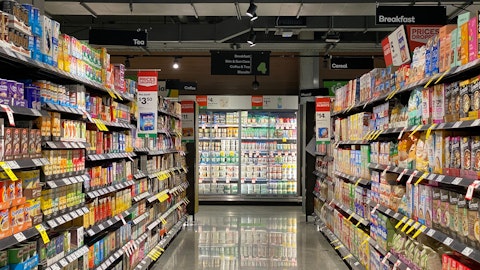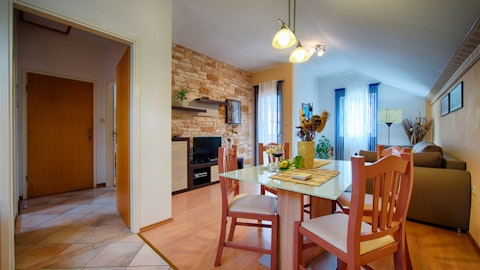Arhaus, Inc. (NASDAQ:ARHS) Q3 2023 Earnings Call Transcript November 4, 2023
Operator: Good morning, and welcome to the Arhaus Third Quarter 2023 Earnings Conference Call. At this time, all participants are in a listen-only mode. A question-and-answer session will follow the formal remarks. Please note that this call is being recorded, and the reproduction of any part of this call is not permitted without written authorization from the company. I will now turn the call over to your host, Wendy Watson, Senior Vice President of Investor Relations. Please go ahead.
Wendy Watson: Good morning, and thank you for joining Arhaus Third Quarter 2023 Earnings Call. On with me today are John Reed, Co-Founder, Chairman and Chief Executive Officer; and Dawn Phillipson, Chief Financial Officer. After prepared remarks, they will be joined by Jen Porter, our Chief Marketing and Ecommerce Officer for the Q&A session. During Q&A, please limit to one question and one follow-up. If you have additional questions, please return to the queue. We issued our earnings press release and our 10-Q for the quarter ended September 30, 2023, before market opened today. Those documents are available on our Investor Relations website at ir.arhaus.com. A replay of the call will be available on our website within 24 hours.
As a reminder, remarks today concerning future expectations, events, objectives, strategies, trends or results constitute forward-looking statements. Actual results or events may differ materially due to a number of risks and uncertainties. For a summary of these risk factors and additional information, please refer to this morning’s press release and the cautionary statements and risk factors described in our annual report on Form 10-K and subsequent 10-Qs as such factors may be updated from time to time in our filings with the SEC. The forward-looking statements are made as of today’s date, and except as may be required by law, the company undertakes no obligation to update or revise these statements. We will also refer to certain non-GAAP financial measures and this morning’s press release includes the relevant non-GAAP reconciliations.
Now I will turn the call over to John.
John Reed: Good morning, everyone, and thank you for joining us today. I first want to call out and thank our teams across Arhaus for delivering another quarter of strong performance. We are very pleased to have reported demand comp growth of 11.7% in the third quarter, a testament to the execution of teams across the company that are developing and delivering our heirloom quality, artisan crafted furniture, assisting clients in our inspirational showrooms and via our ecommerce channel to find and purchase the special pieces that will make their spaces at home. The teams that are continuing to elevate and grow our brand and ensure a first class in-home delivery experience and the teams that support all of the client facing and product facing functions.
Thank you. I’m so proud of all of you. Many of you have asked why Arhaus is consistently outperforming the industry. The why is our passion and our people? We love designing and working with our incredible vendors to produce beautiful furniture that can be enjoyed for generations. Our new collections are some of the most popular we have ever introduced, allowing us to expand these collections into categories and new finishes. We love creating aspirational shareholders where clients can imagine their home of their dreams and expanding to new locations where new Arhaus clients can experience our brand of livable luxury. We are passionate about our products and our client experience, and this is reflected in our performance. Third quarter highlights include net revenue of $326 million, net and comprehensive income of $20 million with a margin of 6.1% and adjusted EBITDA of $34 million with a margin of 10.3%.

We experienced strong demand across all regions, products and channels. Moving to profitability. As we communicated last quarter, we saw an expected year-over-year reduction in earnings, driven primarily by cost and expenses related to our accelerated new showroom openings and our important donation to the Nature Conservancy. Some new initiatives I’m excited about that will elevate our client experience include new processes and some key hires to provide an enhanced final mile delivery experience and more in-home designers as we continue to grow this service. We are also focusing on growing our trade business where we see lots of opportunities in 2024 and beyond. Turning to the showroom growth. We have a very busy week, opening two traditional showrooms tomorrow, one in Coral Gables, Florida and one in Huntington Station, New York.
This will bring our year-to-date new showroom opening to eight. And then in December of this year, we plan to open three additional California showrooms, Las Gatos, Palm Desert, and Newport Beach. We are very proud of how our new showrooms perform right out of the gate, and I wanted to remind you that there is a lag before we begin to see financial benefits hit our income statement due to the normal timing between when a client purchases — makes a purchase in our showrooms and when that purchase is delivered to the client and recognized as revenue. Additionally, our new showrooms are reflected in our report demand comparable growth after they have been open for 13 months and again are reported comparable growth after they have been opened for 15 months.
We have tremendous white [Ph] space to continue to grow our showrooms footprint across the United States, and we expect to accelerate our new showroom openings to five to seven new traditional showrooms annually plus design studios. In 2024, we are targeting another new and sizable new showroom growth with six to eight new traditional showrooms, two new design studios, two to three new outlet locations and approximately 10 relocations, expansions or renovation projects. These new showrooms are in excellent locations and varied as the growth in Los Angeles to a new development in Oklahoma City. In closing, as we finish out 2023 and begin to look at 2024, we are focused on continuing to expand our collection of globally inspired heirloom quality artisan crafted furniture, on growing our showroom footprint with several exciting new locations and are making the investments to support our growth for many years into the future.
I’m excited about the future of Arhaus, and I look forward to continuing to share our journey with you. Now, I’ll turn it over to Dawn.
Dawn Phillipson: Thank you, and good morning. As John described, we are very pleased with our third quarter performance. Key items from our third quarter 2023 income statement include net revenue of $326 million, up $6 million or 1.9%, with a 2.1% comp decline versus Q3 last year when comp growth increased 54.3%. Demand comp growth was 11.7% on a 1-year basis and 99.5% on a 4-year stack basis. Gross margin decreased 4% to $131 million in the quarter. The gross margin decline was primarily due to the sale of price action products that were receded with higher container costs, increased fixed showroom costs as we expand our showroom footprint and higher delivery costs as we elevate our in-home delivery experience. Gross margin as a percent of net revenue decreased 250 basis points to 40%, primarily reflecting higher fixed showroom costs and the higher product and delivery costs.
Third quarter SG&A expense increased 20% to $107 million. The increase was primarily driven by the $10 million donation to the Nature Conservancy, higher selling expense related to new showrooms and demand and increased corporate expense to support the growth of the business. Third quarter 2023 net income decreased 47% to $20 million. Adjusted EBITDA in the quarter decreased 41% to $34 million from $57 million in the third quarter of 2022. Let me now move to our outlook and how we’re thinking about the remainder of 2023. As we announced this morning, we have raised the midpoint of our full year 2023 outlook for net revenue, net income and adjusted EBITDA to reflect our year-to-date performance. Our full year 2023 guidance is outlined in our press release.
This implies an outlook for the fourth quarter of net revenue of $321 million to $341 million, a comp decline of 15% to 9%, net income of $19 million to $24 million and adjusted EBITDA of $40 million to $45 million. Our same [Ph] demand comp growth is in the low single-digit range. For all other details related to our results and outlook, please refer to our press release. Thank you for your attention, and we would now like to open the call up for questions.
See also 12 Best Large Cap Stocks To Buy Now and 11 Best Oil Refinery Stocks To Buy.
Q&A Session
Follow Arhaus Inc. (NASDAQ:ARHS)
Follow Arhaus Inc. (NASDAQ:ARHS)
Receive real-time insider trading and news alerts
Operator: [Operator Instructions] Our first question comes from the line of Steven Forbes with Guggenheim Securities. Please proceed with your question.
Steven Forbes: Good morning John, Dawn, Wendy. Maybe just to start, Dawn, the demand trends you mentioned up low single digits. As we think about the fourth quarter guidance here and the strength and demand that you’ve seen year-to-date, maybe just rephrase to us how we should expect the backlog to work through or flow through the income statement here over the next couple of quarters?
Dawn Phillipson: Good morning, Steve. So we’ve spent a lot of time over the last few months really digging into more granular information than what we’ve had in the past. And what that’s really enabled us to do is get a better handle on the backlog, the abnormal backlog that kind of has been a result that started in 2020 and is carried forward. So we do expect to be through the abnormal backlog by the end of this year. So we’re really pleased with that. We feel good about our strategy, our outbound capacity, our inventory buys. There’s really a few reasons for a higher normalized backlog number that we’re seeing reflected in the information that we have available to us. The first component is we’re really prudently buying into newness.
So as we’re thinking about newness, clients are typically willing to wait a little bit longer. We’re also deploying some pretty good discipline because we don’t know exactly in a particular collection, which finish might take off and which finish might not. So we have certainly our own beliefs and assumptions, but really being prudent in how we’re purchasing into newness to preserve some working capital flexibility. That will result in a bit higher normalized backlog going forward and kind of what we’ve seen over the last few years. The second piece that’s driving a higher normalized backlog number is as we think about showroom cadence and just the number of showrooms that we’re opening, as we’re opening in years we’re opening a high number of showrooms and that are often heavier weighted towards the back half and even in the fourth quarter.
So as you — as we’ve talked about earlier, we have five showrooms opening in the next eight weeks. So that will also result in just a higher carry forward of normalized backlog as we exit this year. So as you think about the timing between when demand is recognized in showrooms versus when deliveries occur and are rolling through net revenue, that’s certainly a component. And then the last piece that I would call out from a normalized backlog perspective is just there’s a higher volume of clients today that are engaging in home-related projects and whether it’s a light refresh of paint, flooring, whether it’s more robust renovations, there’s a higher number of clients who are engaged in those. So there’s a client timing preference that is also resulting in a higher normalized backlog.
So again, we entered this year, anticipating that there was about $100 million of abnormal backlog. The majority of that is still abnormal, but we would expect to deliver that product by the end of the year. And then the component that is just normalized backlog will roll into next year. And then as we think about next year’s revenue, that will also have a higher normalized backlog number, which would then roll into 2025. So we feel really good in general about client lead times and getting product to clients in their homes when they like it. But the backlog number is going to be a little bit higher than perhaps what it was in 2019 and prior.
Steven Forbes: Thanks for the color Dawn. Maybe just a follow-up for either you or John. A lot of focus around growth retail as it pertains to predictability around year one sales and margins. So I was curious if you can maybe remind us or inform us how the 2023 class of stores is performing relative to those pro forma targets for sales and margins? And how you’re thinking about the 2024 class as it pertains to those sort of pro forma productivity targets as well?
John Reed: Yes, sure Steve, I can take that. To answer your question, the new stores, we are very, very happy with. They’ve been performing well at or above our expectations. And we certainly see the new stores that are coming on board here shortly to do the same. A lot of them are in big, big markets where we think we will capitalize a lot of business. Others are in more midsized markets that we always find we do very well. We’re very profitable in. And yes, we’re happy with the whole group. Thank you.
Steven Forbes: Thank you.
John Reed: You’re welcome.
Operator: Our next question comes from the line of Seth Sigman with Barclays. Please proceed with your question.
Seth Sigman: Hey good morning everyone. My first question was really around pricing. Last quarter, you talked about a mid-single-digit average price decrease. I think there were some temporary factors in there. There are other changes that would potentially continue. I’m just curious, how did that play out? How is that playing out? What’s your view on pricing from here? Thank you.
John Reed: Yes, I can take that. Good morning, Seth. I think, as Dawn mentioned before, with the container pricing and so forth and all this inventory we had at higher cost, we kind of whittled that down to a point where we thought we could be a little more aggressive with some of our pricing. And it wasn’t certainly across the board by any means. It was just on some selected pieces. But as we did that, we’re happy with the performance. We’ve seen sales go up on certain collections, and we think we’re at a perfect spot right now to be very, very competitive and hit our margin plans.
Seth Sigman: Okay. Just to follow up on that point. Is your sense that others in the industry have also taken steps to refine pricing or lower pricing on the back of those lower costs? And then my follow-up question is around the gross margin, just trying to understand some pressures this quarter related to those pricing actions. How do you think about that going forward? Are you kind of through that already? And you could start to see more of those freight savings come through. How should we think about that? Thanks.
Dawn Phillipson: Good morning, Seth. So as we think about the gross margin pressures from the third quarter, when we were talking in the second quarter, we had said we felt like the freight benefits that are flowing through would offset some of these price reductions. And there’s a couple of things that caused that not to be exactly as anticipated. So the primary reason is that the mix shift, the product mix shift really skewed a bit more towards these price actions SKUs versus what we originally anticipated. So we saw that those items were really resonating with clients at these price points. So great news is that we are clearing through the product a bit faster than anticipated that we wanted to. The bad news is that there is a little bit of gross margin compression related to that that was unanticipated at the time.


